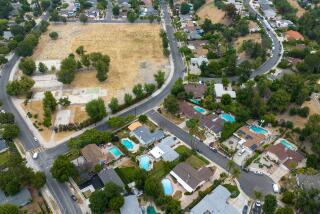Hong Kong aims to solve its housing crisis with an $80-billion artificial island
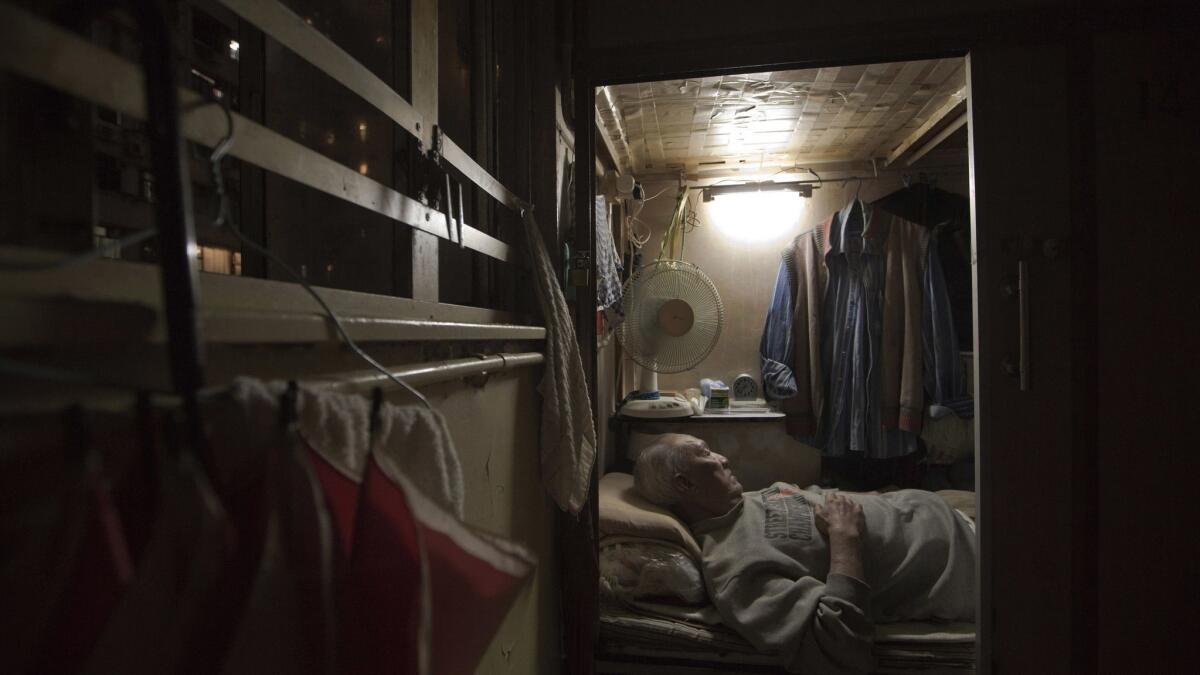
- Share via
Reporting from Hong Kong — Han Li was 72 years old when she moved from Guangdong to Hong Kong. After a lifetime of working in construction in southeast China, she’d come to glitzy Hong Kong, one of Asia’s top financial centers, for a chance to live with her children and newborn grandchildren.
Instead, she found herself alone in an illegal subdivided flat, paying rent of $255 a month for one of 14 windowless, cell-like rooms created from wooden boards, their doors sticking out in a jagged line along a makeshift hallway. Dim light seeped out of the gaps between the boards and the ceiling, revealing cracks on the soiled tile floor.
“I didn’t think it would be like this,” Han said, wrinkling her forehead.
Now 75, she folded herself onto a cot squeezed next to a stained toilet, the floor covered with stacks of newspapers that she had collected to sell. A man shuffled down the hallway, stepping over an exposed water pipe.
Her children also live in subdivided flats and have no room for her. Han’s son works as an air conditioner repairman, her daughters as cashiers. They too cannot afford decent housing in a city where the median cost of a home is 18 times the median household income.
Hong Kong is the world’s most expensive housing market, as well as one of the most densely populated and financially unequal cities in the world. On one end, mansions worth hundreds of millions of dollars stand perched on hilltops with sweeping views of the city. On the other, crammed illegal rooftop shacks and compartmentalized basements of industrial and residential buildings house more than 1.37 million people — 20% of the total population — below the poverty line.
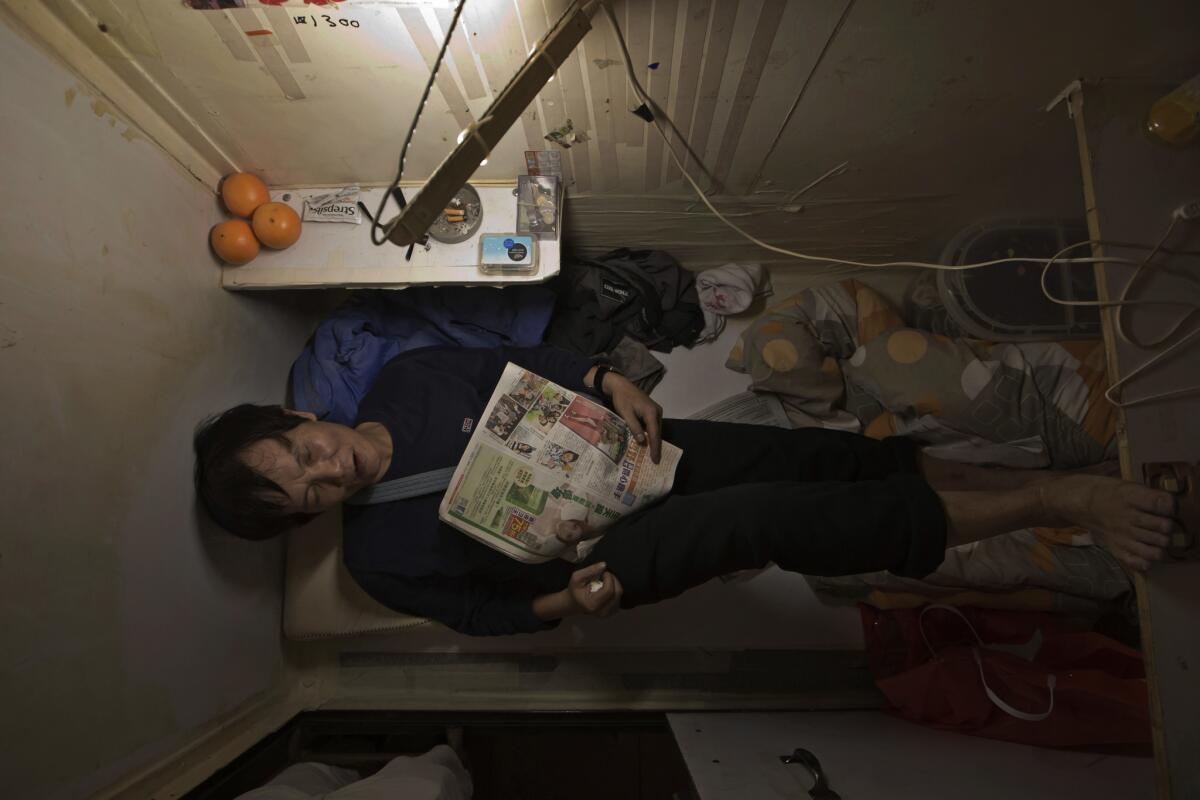
To help cope with the crisis, Hong Kong’s government recently announced a plan to build 4,200 acres of artificial islands in the South China Sea, between the existing Hong Kong and Lantau islands.
The first island would create 2,471 acres of space for a new business district and up to 260,000 flats, authorities said, of which 70% would be public housing. Called Lantau Tomorrow Vision, construction would cost $80 billion — more than half of Hong Kong’s total fiscal reserves — including funds for some of the transport networks around it.
Hong Kong has previously used land reclamation for projects including Hong Kong Disneyland, Hong Kong International Airport and the 18.6-mile Macau-Hong Kong-Zhuhai bridge, which was completed last year after nine years of construction.
Land reclamation typically involves digging up marine mud from the seabed, filling up that area with sand and building on top of it. Aside from disturbing the marine habitat, there’s a risk that the dredged-up mud may be contaminated. Authorities have said they’ll minimize the environmental impact by using methods that don’t involve digging up seabed.
One such method is to inject cement into mud at the bottom of the sea, creating columns strong enough to build on. Another, used in building the new bridge, involves dropping giant steel cells filled with debris onto the seabed to anchor seawalls supporting an artificial island. That method came into question during the bridge’s construction when the structures started drifting from their positions, causing additional costs for repairs and to reinforce the adjoining seawalls.
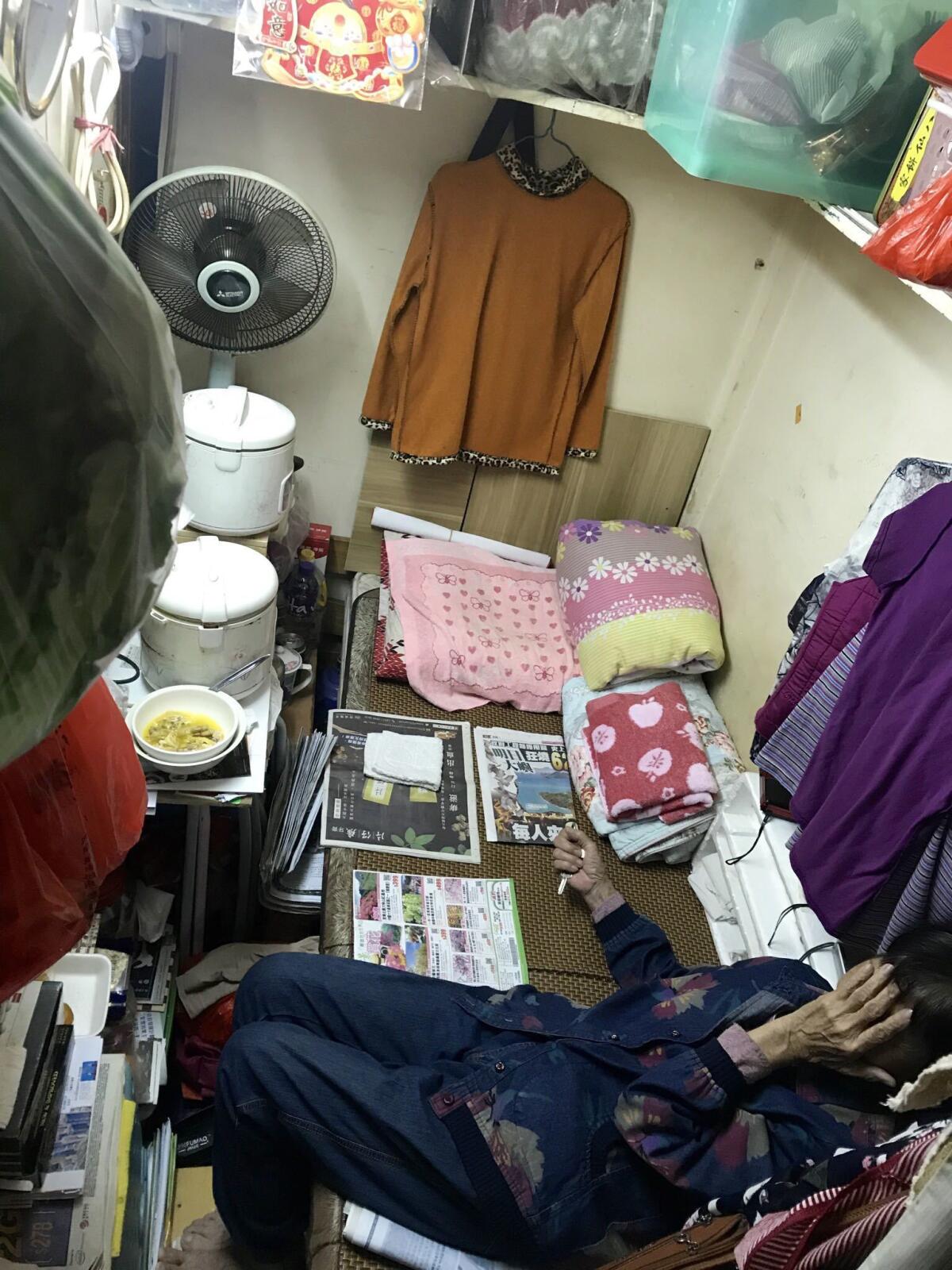
Hong Kong’s 7.4 million inhabitants are concentrated in less than a quarter of the 426-square-mile special administrative region, mostly along the urban shores of Victoria Harbor. Most non-urban areas are protected parks.
Hong Kong’s government says the solution is to find more land. The city needs at least 2,965 acres more land for housing, economic development and improving quality of life, according to a government-commissioned study in 2016.
But critics say the island plan is unreasonably expensive, bad for the environment and prone to catastrophe given the accelerating dangers of climate change.
“With global warming, typhoons are expected to become stronger, bringing even higher storm surges. Latest research also shows that the sea-level rise could be double that of previous projections,” wrote Lam Chiu-ying, a geography professor at the Chinese University of Hong Kong, in a South China Morning Post op-ed. “To go for a gigantic artificial island facing the open sea in a warming world is an unequivocally disastrous move.”
One alternative that has gained public support is repurposing existing former agricultural land — contaminated by industrial pollution and then turned into car parks, storage facilities and recycling sites — for housing.
Environmental and land advocacy groups say Hong Kong’s rural New Territories have 2,545 acres of available former farmland known as brownfields. Developing just half as public housing would cost $33.3 billion, one-fourth the cost of the reclamation project, according to the local chapter of Greenpeace, and would provide 139,000 housing units.
But private landowners operate profitable businesses on the sites that the government says would be difficult to shutter, because the business owners would demand compensation and relocation. “They are an important component of our production chain and it will be unrealistic to expect all of them to disappear from Hong Kong in the future,” the government wrote in a legislative brief.
Those businesses include “more than 50 illegal e-waste dismantling sites, importing toxic e-waste from foreign countries to pollute the environment,” said Andy Chu Kong, a Greenpeace senior campaigner in Hong Kong.
At this point, the government has said that it is already developing more than 800 acres of brownfields, but that it has only limited planning resources and can’t be expected to pursue all options at the same time. Brownfields and Lantau Tomorrow Vision are both part of a “multi-pronged approach” to tackle land supply, according to official statements.
Some opponents also contend that government plans fail to address an overarching problem: a housing policy that favors private developers over public need, driving up prices of both rentals and sales while reducing the supply of affordable units.
One factor, they say, is Hong Kong’s tax system, which provides incentives to keep housing prices high. With relatively low income and business taxes, in keeping with the territory’s laissez-faire financial identity, Hong Kong instead gets more than one-third of its revenue from land sales and a “stamp tax” on property transactions. As a result, higher property values mean more government revenue.
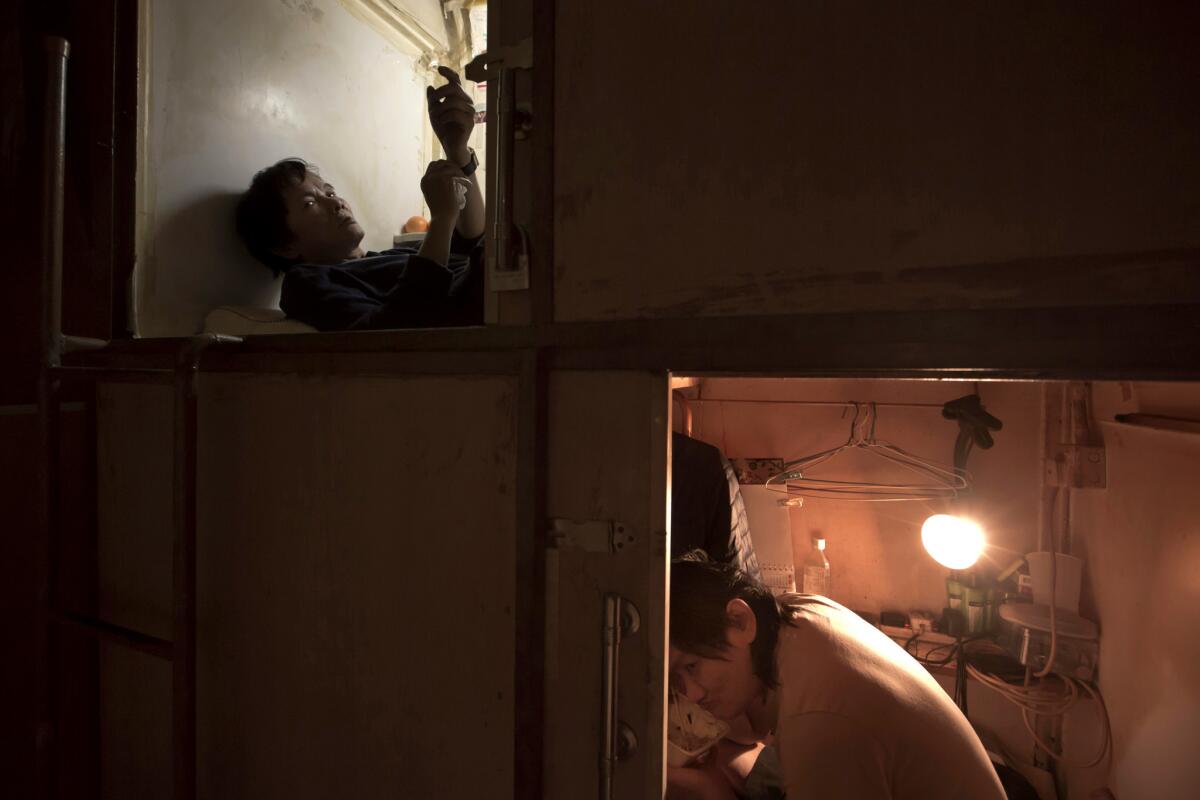
Hoarding of empty flats to drive sales prices up has also been a problem for years, with developers keeping more than 9,000 new flats off the market as of June, according to government data.
Last year, Hong Kong Chief Executive Carrie Lam proposed a vacancy tax that would penalize hoarders, and within two months, more than 1,600 of the units were sold off.
The tax, however, has yet to be approved.
Hong Kong’s housing crunch has also been attributed to a government decision in 1997 to halt public housing construction planning at the time the Asian financial crisis hit.
By 2004, the economy was recovering, but the city never returned to pre-crisis construction levels.
“When the economy is bad, the government should build more,” said Yiu Ching-hei, a researcher at Liber Research Community, a local think tank. “But instead, they stop and get out of the market.”
In Hong Kong, a tale of two sit-ins – gritty and intellectual »
According to a 2016 government report, at least 209,700 Hong Kong residents reside in subdivided flats with a median size of 57 square feet per person. Many units, such as the one Han lives in, appear to be clearly in violation of building safety standards, with obvious fire and hygiene hazards.
At this point, Han and her children are among 250,000 applicants on a waiting list for public housing, government-subsidized rentals meant for single people who earn less than $1,500 monthly and have net assets up to $32,000, and couples who earn up to $2,200 a month and have a maximum $43,100 in savings.
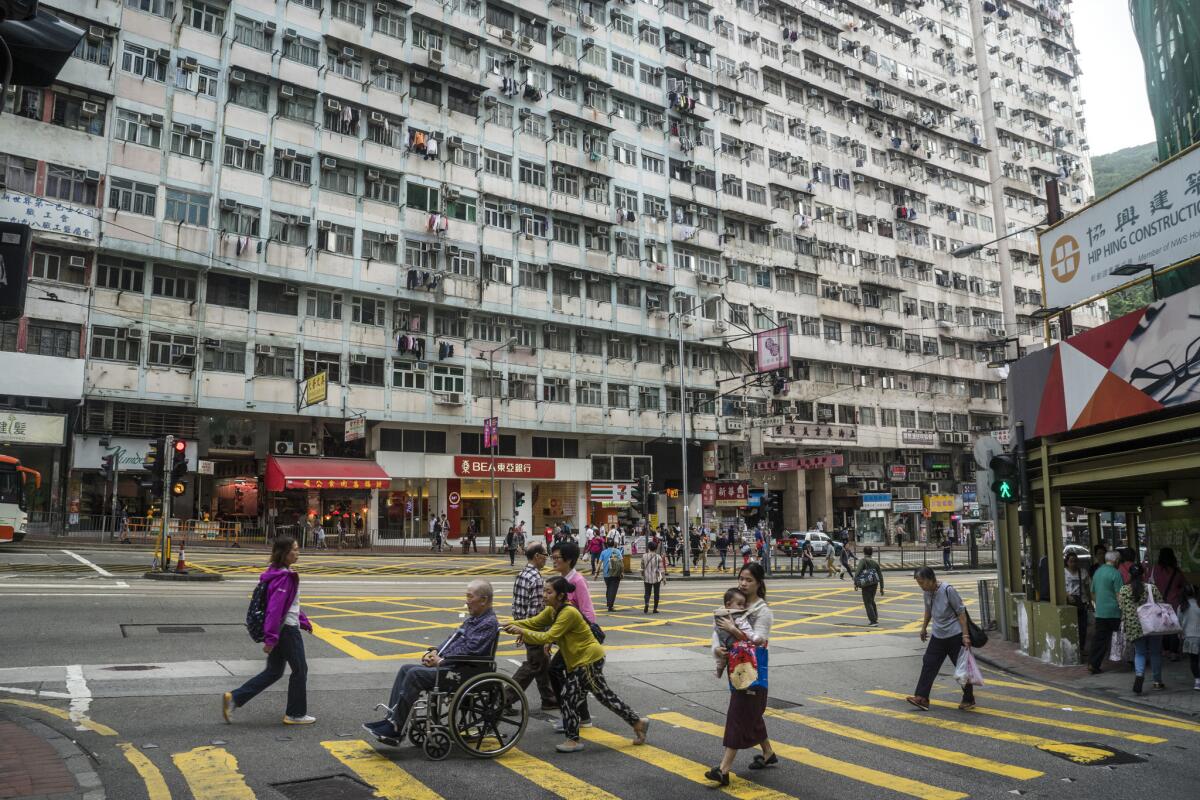
About 30% of Hong Kong’s population lives in public rental housing.
Hong Kong’s government is seeking funding for the new island from the territory’s legislature and it’s likely to be approved. Some Hong Kongers worry that such projects, in which mainland Chinese companies win construction contracts, amount to a way to funnel money to Beijing and tighten Hong Kong’s integration into the “greater Bay Area,” the Chinese government’s scheme to integrate Hong Kong with surrounding Chinese cities.
”We have a legislative council that is controlled by Beijing power, so if they are determined to go forward, then I don’t think at this point we can stop it,” said opposition lawmaker Eddie Chu.
Yet the plan means little to Hong Kong’s urban poor, he added.
“People living in a desperate housing situation are now used as an excuse to support the artificial island and all those new developments, but in the end they are not the ones who can benefit from it,” said Chu. “What makes us furious is when we ask, ‘Where do we have the money to fund that artificial island?’ the government says we will have soaring land prices and we can earn money from that.
“But the basic reason we need so much land is to make housing more affordable. They’ve turned it all around,” Chu said.
In any case, the proposed island won’t be livable until 2032 at the earliest, too late to answer Han’s dreams.
“I want a bigger trolley so I can collect cardboard because it’s worth more,” she said, clutching at her chest. “And I want to live in one place with my family before I die.”
California’s housing shortage has companies carving up apartments to lower the rent »
Rents on Rodeo Drive are cheap compared with Hong Kong and New York »
More to Read
Sign up for Essential California
The most important California stories and recommendations in your inbox every morning.
You may occasionally receive promotional content from the Los Angeles Times.
